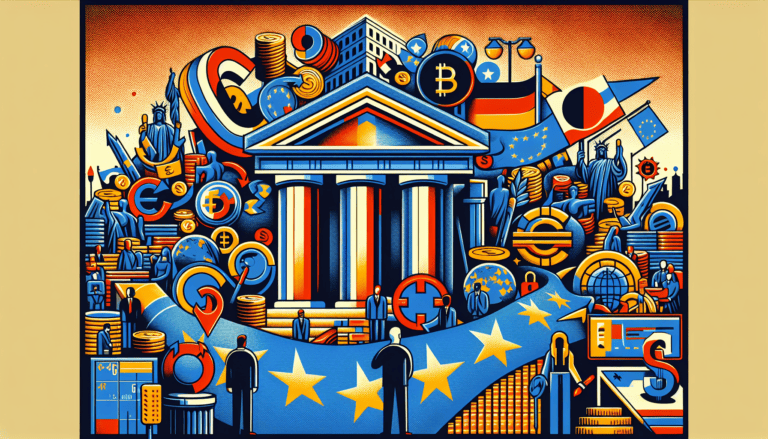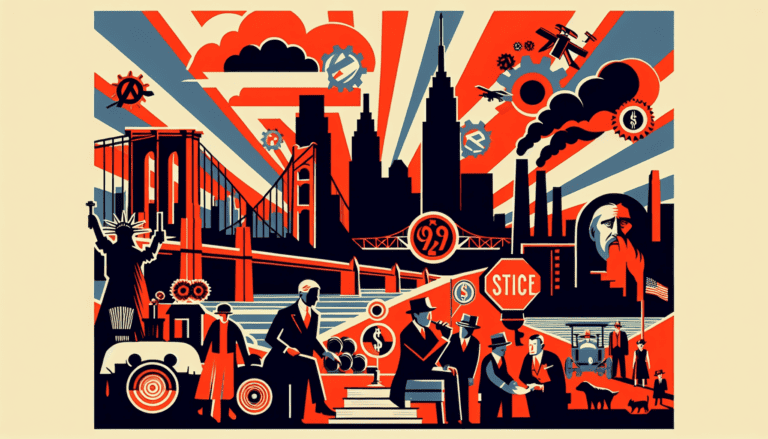Navigating Financial Turbulence: Unveiling the Causes of the Savings and Loan Crisis

Understanding Financial Market Crises
Before diving into the specifics of the savings and loan crisis, it’s essential to establish a foundational grasp on financial market crises as a whole. These events are complex and can have far-reaching consequences for economies and investors.
Historical Context of Crises
Financial market crises are not a modern phenomenon; they’ve occurred throughout history, often with devastating effects on economies and societies. Examples range from the Tulip Mania of the 1600s to the Great Depression of the 1930s and more recent events such as the 2008 global financial crisis. Each crisis, while unique in its specifics, often shares commonalities with others in terms of causes and effects.
Identifying Common Causes
The causes of financial market crises can be varied and complex, but several key factors often play a role:
- Regulatory Failures: Inadequate oversight (the role of regulatory failures in financial crises) can lead to unchecked risk-taking and market imbalances.
- Economic Imbalances: Issues like inflation, asset bubbles (the housing market bubble and subprime mortgage crisis), and excessive leverage (the impact of excessive leverage on financial stability) can precipitate crises.
- Speculative Behavior: Irrational exuberance and speculative attacks (the impact of speculative attacks on currencies) can greatly amplify risks.
- Market Psychology: Fear and greed can drive herd behavior, leading to market bubbles and subsequent crashes (black monday 1987: the stock market crash).
- Financial Contagion: Crises can spread between institutions and countries, exacerbated by interconnected financial systems (financial contagion and cross-border effects).
- Mismanagement and Fraud: Insider abuse and deceptive practices can undermine trust and stability.
By understanding these common causes, we can better comprehend why a crisis like the savings and loan debacle occurred and how similar situations might be averted or mitigated in the future (crisis prevention: lessons from past financial crises).
In the next sections, we will delve into the specifics of the savings and loan crisis, unraveling the causes of the savings and loan crisis and examining the regulatory and economic landscapes that allowed it to unfold.
The Savings and Loan Crisis Overview
The Savings and Loan (S&L) Crisis was a significant financial disaster that affected the United States during the 1980s and early 1990s. This section provides an overview of the origins and a timeline of events that unfolded during the crisis, laying the groundwork for a deeper understanding of what led to this tumultuous period in the financial sector.
Origins of the Crisis
The roots of the S&L Crisis can be traced back to several key factors that together created a perfect storm for financial instability. At the core was a flawed financial structure known as “Asset/Liability Mismatch.” S&L institutions borrowed short-term funds at low-interest rates to invest in long-term, higher-yielding assets, exposing them to significant interest rate risk.
In October 1979, the Federal Reserve raised the discount rate from 9.5 percent to 12 percent to combat inflation, leading S&Ls to struggle with attracting capital due to the fixed interest rates on long-term loans. This change resulted in approximately one-third of S&Ls becoming insolvent, which was the beginning of the crisis.
The deregulation of the S&L industry further compounded the crisis. This deregulation, combined with regulatory forbearance, allowed S&Ls to pursue highly speculative investment strategies. Notable cases such as Charles Keating’s Lincoln Savings and Loan Association, which had a negative net worth of over $100 million, highlighted the consequences of such risky practices (Wikipedia).
Timeline of Events
| Year | Event |
|---|---|
| 1979 | The Federal Reserve increases the discount rate significantly to combat inflation. |
| 1980 | Deregulation begins, allowing S&Ls to expand their activities. |
| 1982 | The Garn–St. Germain Depository Institutions Act is passed, leading to further deregulation. |
| 1986 | The crisis becomes public as the number of failing S&Ls skyrockets. |
| 1989 | The Financial Institutions Reform, Recovery, and Enforcement Act (FIRREA) is enacted. |
| 1995 | The crisis concludes with over a thousand S&Ls closed or merged. |
The timeline indicates a rapid escalation of the crisis in the mid-1980s, with a substantial number of S&Ls failing. By 1989, the crisis became the most costly financial debacle in U.S. history up to that time, with an estimated taxpayer expense of around $125 billion. The government’s response, including the formation of the Resolution Trust Corporation and legislative reforms, aimed to address the immediate damage and prevent future occurrences of similar crises.
For further insights into financial crises, explore our articles on the European debt crisis explained and the role of regulatory failures in financial crises. Additionally, understanding the 2008 global financial crisis and the dot-com bubble burst of 2000 can provide context for the broader patterns and causes of financial market crises.
Key Factors Behind the Crisis
The Savings and Loan (S&L) Crisis, which occurred in the late 1980s and early 1990s, was a significant event that reshaped the financial landscape in the United States. Several key factors contributed to the crisis, including interest rate volatility, deregulation, and asset/liability mismatch.
Interest Rate Volatility
A primary cause of the Savings and Loan Crisis was the mismanagement of interest rate risks by the thrift institutions themselves. These institutions traditionally relied on borrowing short-term funds at low rates to invest in long-term, fixed-rate mortgages. When interest rates rose sharply during the late 1970s and early 1980s, many S&Ls found themselves paying more for short-term funds than they were earning from their long-term investments, resulting in significant financial losses (Federal Reserve History).
| Period | Short-term Interest Rates | Long-term Investment Yields |
|---|---|---|
| Late 1970s – Early 1980s | High | Low |
The above table illustrates the disparity between the cost of short-term borrowing and the yield from long-term investments that contributed to the crisis.
Deregulation Impact
The impact of deregulation on the S&L industry was another critical factor that exacerbated the crisis. Deregulatory measures allowed S&Ls to take on riskier investments and increased competition, which led to more aggressive lending practices. The increased competition among financial institutions pushed many S&Ls to pursue high-yield, high-risk strategies, including speculative real estate investments and commercial loans (Federal Reserve History). These risky endeavors ultimately contributed to the instability and collapse of many S&Ls when the investments failed to provide expected returns and real estate values began to plummet.
Asset/Liability Mismatch
The “Asset/Liability Mismatch” was a flawed financial structure that played a pivotal role in the crisis. S&Ls borrowed short-term funds at lower interest rates to invest in long-term, higher-yielding assets. This practice led to significant interest rate risk and vulnerability during periods of rising interest rates. As rates increased, S&Ls faced escalating costs without corresponding increases in their asset yields, leading to severe liquidity issues and insolvency for many institutions (FDIC).
| Asset Type | Rate Type | Interest Rate Risk Exposure |
|---|---|---|
| Long-term assets | Fixed-rate | High |
| Short-term liabilities | Variable-rate | High |
Understanding the complexities behind the S&L crisis is crucial for beginner investors looking to grasp the intricacies of financial markets. These factors underscore the importance of sound risk management and regulatory oversight, themes that resonate across various financial market crises and their causes. As such, the S&L crisis serves as an informative case study, offering lessons that are applicable to modern financial markets and the potential pitfalls investors may encounter.
Regulatory Failures
As we explore the causes of the savings and loan crisis, it is evident that regulatory failures played a pivotal role in its escalation. The lack of robust oversight allowed for an environment where risky financial practices could thrive, ultimately contributing to the collapse of many savings and loan institutions.
Inadequate Supervision
The Savings and Loan Crisis of the 1980s was significantly exacerbated by the lack of effective supervision from regulatory agencies. While financial institutions typically operate under stringent regulatory oversight to ensure their stability and soundness, this was not the case for the thrift industry during the crisis. According to the Federal Deposit Insurance Corporation (FDIC), there was a noticeable deficiency in the enforcement of regulations, which permitted savings and loan associations (S&Ls) to engage in high-risk investment practices without adequate scrutiny.
These high-risk activities included speculative real estate investments and aggressive lending practices that were not matched with sufficient capital reserves. The consequences of this inadequate supervision were dire, as they undermined the very foundation of trust and security that is essential for the functioning of financial markets.
Consequences of Forbearance
The concept of forbearance refers to the regulatory decision to allow financially distressed institutions to continue operations in the hope that they might recover. However, during the Savings and Loan Crisis, this practice led to detrimental outcomes. The Federal Savings and Loan Insurance Corporation (FSLIC), the entity responsible for insuring deposits in S&Ls, sometimes allowed troubled institutions to remain open, exacerbating the crisis by increasing the cost of eventual bailouts.
The table below outlines some of the key consequences of forbearance during the crisis:
| Forbearance Decision | Consequence |
|---|---|
| Delaying closure of troubled S&Ls | Escalation of losses and instability |
| Allowing continued risky practices | Amplification of financial distress |
| Inadequate response to initial signs of crisis | Prolonged and deepened impact on financial markets |
The outcomes of forbearance demonstrate the critical need for regulatory bodies to act decisively and swiftly when faced with signs of financial distress. When agencies delay necessary interventions, the risk of severe financial repercussions increases, affecting not only individual institutions but also the broader economy.
Understanding the regulatory failures that contributed to the Savings and Loan Crisis offers valuable insights for the prevention of future financial market crises. It underscores the need for competent supervision and the dangers of allowing financial institutions to operate without proper oversight. For more on the broader implications of financial market crises and their management, explore the future of financial crisis management.
Economic Conditions and Effects
The Savings and Loan Crisis, a significant debacle in the history of financial market crises, was not only a result of regulatory mishaps but also deeply intertwined with prevailing economic conditions. The crisis’s impact on Savings and Loan (S&L) institutions was profound, leading to one of the costliest financial system failures in the United States.
Inflation and Real Estate Downturn
The late 1970s and early 1980s witnessed a period of surging inflation rates, which resulted in the Federal Reserve increasing interest rates in an attempt to control the inflationary spiral. This economic backdrop had a dire impact on the real estate market, causing a severe downturn. S&L institutions, with portfolios heavily concentrated in long-term, fixed-rate mortgages, found themselves in a precarious position as their cost of funds rose sharply while their interest income remained stagnant (Federal Reserve History).
The table below illustrates the rising inflation rates during the onset of the crisis:
| Year | Inflation Rate (%) |
|---|---|
| 1978 | 7.6 |
| 1979 | 11.3 |
| 1980 | 13.5 |
| 1981 | 10.3 |
Impact on S&L Institutions
The impact on S&L institutions was devastating. The high interest rate environment of the early 1980s caused these institutions to pay out more in interest on deposits than they were receiving from their long-term mortgage loans. This mismatch between asset yields and the cost of liabilities led to significant losses (Federal Reserve History).
As the real estate market plummeted, S&Ls faced skyrocketing loan defaults, with diminishing property values eroding their collateral base. The financial distress was exacerbated by the steep recession, which further drove up loan defaults and reduced new mortgage originations. The culmination of these factors resulted in widespread failures among S&L institutions, with the following data highlighting the rising number of failures:
| Year | Number of S&L Failures |
|---|---|
| 1980 | 10 |
| 1984 | 79 |
| 1986 | 138 |
| 1989 | 318 |
The ramifications of the crisis were severe, affecting not only the S&L industry but also the broader economy. The federal government’s intervention, including the formation of the Resolution Trust Corporation and legislative reforms, aimed to stabilize the financial system and restore public confidence (Federal Reserve History). The crisis’s cost to taxpayers and depositors was substantial, with estimates of the total cost to the U.S. government exceeding $160 billion.
Understanding the economic conditions and effects of the Savings and Loan Crisis provides critical insights into the vulnerabilities of financial institutions and the importance of maintaining a resilient and well-regulated financial system. It also serves as a cautionary tale for investors and policymakers, underscoring the role of regulatory failures in financial crises and the need for crisis prevention strategies.
Fraud and Insider Abuse
The Savings and Loan Crisis was not solely a product of market forces and regulatory changes; it also involved considerable fraudulent activities and insider abuse. Understanding the role of misconduct is essential to grasping the full scope of the causes of the savings and loan crisis.
Examples of Misconduct
Instances of misconduct during the Savings and Loan Crisis were varied and widespread. Insider abuse took many forms, from embezzlement to outright criminal activities. Executives and insiders of Savings and Loan institutions often exploited deregulation to engage in self-dealing and risky investments, which led to significant financial losses. For example, there were cases where executives approved loans for projects in which they had a personal financial interest, without adequate collateral or due diligence.
According to Federal Reserve History, these fraudulent and speculative activities by S&L insiders and developers played a significant role in the crisis. Additionally, the FDIC highlights that embezzlement and other forms of criminal behavior within the thrift industry led to considerable instability in the financial system.
A notable example of such misconduct was the Lincoln Savings and Loan Association scandal, which involved substantial real estate lending violations and became emblematic of the broader crisis.
Role in the Crisis
The role of fraud and insider abuse in exacerbating the Savings and Loan Crisis cannot be overstated. These activities not only led to direct financial losses but also eroded public trust in the financial system. The Federal Reserve History notes that some S&L executives took advantage of weak regulatory mechanisms to perpetrate fraud, often precipitating the collapse of their institutions.
The cumulative effect of these illicit activities added significant strain to the already troubled Savings and Loan sector. As a result, the costs to address the crisis increased substantially, with repercussions felt across the entire financial system. It became clear that effective regulation and oversight were essential to prevent such widespread abuse and its detrimental effects on market stability.
For more insights on how mismanagement and poor regulatory practices have influenced financial markets, readers can explore content on the role of regulatory failures in financial crises and crisis prevention: lessons from past financial crises. Understanding these elements is crucial for beginner investors as they navigate through the overview of financial market crises and learn about the future of financial crisis management.
Government Response and Aftermath
Following the devastating impact of the savings and loan crisis on the financial sector and the economy, the U.S. government took decisive action to manage the fallout and prevent such a disaster from reoccurring.
Formation of Resolution Trust Corporation
In the wake of the crisis, the U.S. government established the Resolution Trust Corporation (RTC) in 1989. The primary function of the RTC was to oversee the resolution and liquidation of assets from failed savings and loan institutions (S&Ls). The RTC played a critical role in stabilizing the financial markets by disposing of assets in a manner that maximized taxpayer recovery and minimized the impact on the economy. The creation of the RTC was a monumental task, involving the marshaling of vast resources to handle the unprecedented number of failed S&Ls, which eventually led to the U.S. government expending over $100 billion in bailout funds. (Federal Reserve History)
The RTC’s establishment was also significant as it provided a blueprint for handling similar financial crises in the future. It demonstrated the government’s willingness to intervene directly in the financial markets to restore confidence and prevent a deeper economic crisis.
Legislative Reforms Enacted
In response to the causes of the savings and loan crisis, Congress passed the Financial Institutions Reform, Recovery, and Enforcement Act (FIRREA) of 1989. FIRREA was a comprehensive piece of legislation that introduced significant changes to the regulation of S&Ls and the entire banking sector. Some of the key reforms included:
- The abolition of the Federal Savings and Loan Insurance Corporation (FSLIC) and the creation of the Office of Thrift Supervision (OTS) to oversee S&Ls.
- The establishment of new capital requirements for S&Ls to ensure they had sufficient financial resources to cover potential losses.
- An increase in the powers of the Federal Deposit Insurance Corporation (FDIC), allowing it to provide oversight and insurance for both banks and S&Ls.
These legislative reforms aimed to strengthen the financial regulatory framework and reduce the likelihood of a similar crisis occurring in the future. By enhancing regulatory oversight, improving risk management practices, and bolstering depositor protection mechanisms, FIRREA sought to create a more stable and secure financial environment.
The government’s response to the savings and loan crisis also provided lessons for future crisis management strategies, including the importance of swift and decisive action, the necessity of adequate regulatory oversight, and the value of transparency in financial operations. As investors continue to navigate financial markets, understanding the overview of financial market crises and the government’s role in mitigating these crises is quintessential.
The reforms enacted in the aftermath of the savings and loan crisis have had a lasting impact on the financial industry. They have shaped the way regulatory bodies approach oversight and how financial institutions manage risk. For those interested in broader financial market dynamics, exploring topics like the 2008 global financial crisis: an analysis and the role of regulatory failures in financial crises can provide deeper insight into the complexities of financial stability and crisis prevention.





